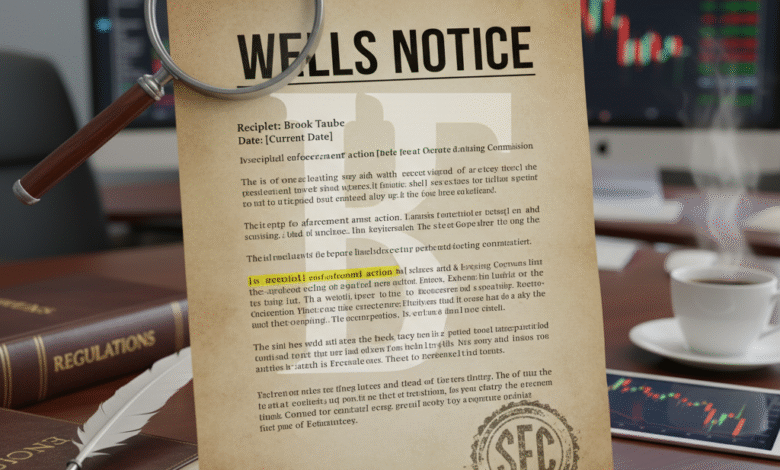Brook Taube Wells Notice: What It Means and Why It Matters

Introduction
When a prominent figure in the finance world receives a Wells Notice from the SEC, it sends ripples through the investment community. That’s exactly what happened when Brook Taube, co-founder of Medley Management, found himself facing regulatory scrutiny. But what does a Wells Notice actually mean? And why should investors, financial professionals, and anyone interested in market regulations care about this case?
A Wells Notice isn’t a formal charge—it’s more like a warning shot. It gives recipients a chance to respond before the Securities and Exchange Commission decides whether to file enforcement actions. In Brook Taube’s case, understanding the circumstances surrounding this notice offers valuable insights into regulatory compliance, corporate governance, and what happens when things go wrong in asset management.
Let’s break down everything you need to know about the Brook Taube Wells Notice, from the background story to its broader implications for the financial industry.
Who Is Brook Taube?
Before diving into the Wells Notice itself, it’s important to understand who Brook Taube is and why this matters.
Brook Taube is a well-known figure in private credit and asset management circles. Along with his brother Seth Taube, he co-founded Medley Management Inc., a firm that specialized in providing capital solutions to middle-market companies. Under his leadership, Medley grew into a significant player in the alternative investment space, managing billions in assets.
Key accomplishments include:
- Co-founding Medley Management in 2006
- Building a portfolio focused on direct lending and credit strategies
- Taking Medley public through an IPO in 2014
- Serving on multiple boards and advisory positions
However, despite these achievements, Medley faced mounting challenges that eventually caught the attention of regulators.
What Is a Wells Notice?
A Wells Notice is an official notification from the SEC indicating that the agency’s staff has made a preliminary determination to recommend enforcement action against an individual or company. It’s named after John Wells, who chaired the advisory committee that proposed this notification system in 1972.
Here’s what makes it significant:
The notice gives recipients an opportunity to submit a “Wells Submission”—essentially a written argument explaining why the SEC shouldn’t pursue charges. This pre-enforcement notification is designed to be fair, allowing targets to present their side before formal proceedings begin.
However, receiving a Wells Notice is serious business. While it’s not a formal charge, it strongly suggests that enforcement action is likely unless the recipient can convince the SEC otherwise. Statistics show that the majority of Wells Notices eventually result in formal charges or settlements.
The Brook Taube Wells Notice: What Happened?
The Brook Taube Wells Notice stems from issues related to Medley Management’s operations and disclosures. While the SEC doesn’t publicly announce Wells Notices (recipients sometimes disclose them voluntarily or through regulatory filings), reports indicate that the notice centered on concerns about how Medley managed conflicts of interest, fee structures, and disclosures to investors.
The timeline of events includes:
Medley faced deteriorating financial performance in the years following its 2014 IPO. The firm struggled with declining assets under management, fee pressure, and operational challenges. By 2019, Medley’s stock price had plummeted from its initial offering price, and the company was exploring strategic alternatives.
In 2019, Medley announced it had received Wells Notices for both the company and certain executives, including Brook Taube. The SEC’s concerns reportedly focused on disclosure practices, particularly around affiliated transactions and fee arrangements that may not have been adequately communicated to investors and board members.
Why Did the SEC Issue the Wells Notice?
The SEC’s enforcement division issues Wells Notices when it believes there’s sufficient evidence of potential securities law violations. In the case of Brook Taube and Medley Management, several factors likely contributed to the regulatory scrutiny.
Disclosure Concerns
One of the primary issues involved how Medley disclosed certain transactions and relationships to investors. The SEC places enormous importance on transparency, especially when it comes to conflicts of interest and fee arrangements that could impact investor returns.
Affiliated Transactions
When investment firms engage in transactions with affiliated entities, they must disclose these relationships clearly. Questions arose about whether Medley adequately informed investors about dealings between different entities within the Medley structure and how these relationships might create conflicts.
Fiduciary Duties
Investment advisers have a fiduciary duty to act in their clients’ best interests. The SEC investigates cases where this duty may have been compromised, particularly when advisers stand to benefit at the expense of the investors they serve.
Fee Structures and Calculations
Complex fee arrangements require clear disclosure. If investors don’t fully understand how fees are calculated or what they’re paying for, it can constitute a violation of securities laws.
The Impact on Medley Management
The Wells Notice and subsequent regulatory scrutiny had profound effects on Medley Management as a company.
Financial and operational consequences included:
The company’s already-struggling stock price faced additional pressure as news of the Wells Notices became public. Investor confidence eroded further, making it even more difficult for Medley to attract and retain assets under management.
In 2021, Medley ultimately agreed to a settlement with the SEC without admitting or denying the allegations. The company and certain executives, including Brook Taube, paid penalties totaling several million dollars. The settlement resolved the SEC’s charges related to disclosure failures and conflicts of interest.
Following the settlement, Medley underwent significant restructuring. The firm eventually merged parts of its business with other entities and dramatically scaled back operations from its peak years.
What This Means for Investors
The Brook Taube Wells Notice case offers several important lessons for investors, particularly those invested in alternative asset managers or private credit funds.
Due Diligence Is Critical
Investors should thoroughly research investment firms before committing capital. Understanding fee structures, potential conflicts of interest, and the track record of management teams can help identify red flags early.
Read the Fine Print
Disclosure documents exist for a reason. While they can be dense and technical, these materials contain crucial information about how your investments are managed, what fees you’re paying, and what risks you face.
Regulatory Actions Are Warning Signs
When a firm or its executives receive Wells Notices or face other regulatory scrutiny, it’s a signal to pay attention. Even if charges are never filed or are eventually settled, the underlying issues that attracted regulatory attention often indicate deeper problems.
Diversification Matters
Concentrating investments with a single firm or strategy increases risk. The Medley situation demonstrates how quickly an investment manager can face challenges that impact performance and asset recovery.
Broader Implications for the Financial Industry
The case has implications that extend beyond Medley Management and Brook Taube personally.
Increased Regulatory Scrutiny
The SEC has intensified its focus on asset managers, particularly in the private credit and alternative investment space. The agency is paying closer attention to fee arrangements, conflicts of interest, and disclosure practices across the industry.
Compliance Culture
Financial firms are investing more heavily in compliance infrastructure. The cost of regulatory violations—both financial penalties and reputational damage—has made robust compliance programs essential rather than optional.
Transparency Expectations
Regulators and investors alike are demanding greater transparency from investment managers. Complex structures and fee arrangements that were once considered acceptable now face heightened scrutiny.
Personal Accountability
The SEC increasingly holds individual executives accountable for compliance failures, not just the companies they lead. Wells Notices issued to individuals like Brook Taube demonstrate that leadership can’t hide behind corporate structures when violations occur.
How to Respond to a Wells Notice
While most people will never receive a Wells Notice, understanding the response process is valuable for anyone in the financial industry.
Hire Experienced Legal Counsel
Responding to a Wells Notice requires specialized securities law expertise. The Wells Submission is often the last chance to avoid formal charges, making quality legal representation essential.
Thoroughly Investigate the Facts
Before responding, conduct an internal investigation to understand exactly what happened. You need to know the facts before you can effectively argue your case to the SEC.
Craft a Persuasive Wells Submission
The written response should address each of the SEC’s concerns directly, present mitigating factors, explain any misunderstandings, and argue why enforcement action isn’t warranted or should be limited.
Consider Settlement Options
Many Wells Notice recipients ultimately settle with the SEC. Settlement allows both parties to avoid the time and expense of litigation, though it typically involves financial penalties and other remedial measures.
Lessons from the Brook Taube Case
Several key takeaways emerge from examining the Brook Taube Wells Notice and its aftermath.
For financial professionals:
Build a culture of compliance from day one. Don’t wait until you’re successful to implement proper controls and disclosure practices. When conflicts of interest exist, disclose them clearly and completely. Transparency builds trust and reduces regulatory risk.
For investors:
Understand that past performance doesn’t guarantee future results, especially when regulatory issues emerge. Stay informed about the firms managing your money, including any regulatory actions or investigations they face.
For regulators:
The case demonstrates the importance of proactive enforcement and the value of the Wells Notice process in giving potential defendants a fair opportunity to respond before formal charges are filed.
The Current Status of Brook Taube
Following the settlement with the SEC, Brook Taube has maintained a lower public profile than during Medley’s growth years. Like many executives who face regulatory actions, he’s had to navigate the reputational and professional consequences of the Wells Notice and subsequent settlement.
The case serves as a reminder that even experienced and previously successful financial professionals can face regulatory scrutiny when disclosure practices and conflict management fall short of regulatory standards.
Conclusion
The Brook Taube Wells Notice represents more than just one executive’s regulatory troubles—it’s a case study in the importance of transparency, proper disclosure, and robust compliance in the asset management industry. For Brook Taube and Medley Management, what began as concerns about affiliated transactions and fee disclosures ultimately led to penalties, restructuring, and lasting reputational impact.
Whether you’re an investor evaluating where to place your capital, a financial professional building a business, or simply someone interested in how securities regulations work, this case offers valuable insights. The SEC’s enforcement priorities are clear: transparency matters, conflicts must be managed properly, and fiduciary duties are not negotiable.
As the financial industry continues to evolve and regulators maintain their vigilant oversight, the lessons from this case remain relevant. Understanding what happened with Brook Taube and Medley Management can help investors make better decisions and help financial professionals avoid similar pitfalls.
Have thoughts on this case or questions about Wells Notices? Share your comments below or reach out to a securities attorney for personalized guidance on regulatory compliance matters.
Frequently Asked Questions (FAQs)
What exactly is a Brook Taube Wells Notice and why was it issued?
The Brook Taube Wells Notice was a preliminary enforcement notification from the SEC indicating that agency staff intended to recommend charges related to disclosure failures and conflicts of interest at Medley Management. The notice was issued because the SEC believed that Medley and certain executives, including Brook Taube, failed to adequately disclose affiliated transactions and fee arrangements to investors. This gave Taube an opportunity to respond before formal charges were filed, though the case ultimately resulted in a settlement with financial penalties.
How common are Wells Notices in the financial industry?
Wells Notices are relatively common enforcement tools used by the SEC, with hundreds issued annually across various sectors of the financial industry. However, they’re still significant events that indicate serious regulatory concerns. Not everyone who receives a Wells Notice ends up facing formal charges—some successfully argue their case in Wells Submissions and avoid prosecution. Nevertheless, statistics suggest that the majority of Wells Notices do lead to either formal charges or negotiated settlements, making them serious matters that require immediate legal attention.
What happened to Medley Management after the Brook Taube Wells Notice?
After receiving the Wells Notice, Medley Management faced significant challenges including declining investor confidence, continued financial struggles, and operational difficulties. In 2021, the company settled with the SEC, paying penalties without admitting or denying wrongdoing. Following the settlement, Medley underwent substantial restructuring, merged parts of its business with other entities, and dramatically scaled back from its peak operations. The firm’s public market presence essentially ended, marking a stark contrast to its earlier ambitions as a publicly-traded alternative asset manager.
Should investors be concerned when executives receive Wells Notices?
Yes, investors should definitely pay attention when executives or firms they’re invested with receive Wells Notices. While a Wells Notice isn’t a formal charge and doesn’t necessarily mean wrongdoing occurred, it indicates that the SEC has serious concerns worth investigating. Investors should review their positions, read available disclosures carefully, and consider whether the regulatory scrutiny reveals underlying problems with the investment strategy, management practices, or risk profile. In many cases, Wells Notices signal deeper issues that could impact investment performance and principal recovery.
What are the key lessons from the Brook Taube Wells Notice case for investment professionals?
The Brook Taube case teaches several critical lessons for investment professionals. First, disclosure must be complete, clear, and accurate—especially regarding conflicts of interest and fee structures. Second, compliance infrastructure should be built into operations from the start, not added as an afterthought. Third, affiliated transactions require extra scrutiny and transparency to avoid regulatory concerns. Fourth, even successful track records don’t protect against enforcement actions when disclosure standards aren’t met. Finally, personal accountability matters—executives can face individual consequences for compliance failures, not just their firms. Building a strong culture of transparency and regulatory compliance is essential for long-term success in asset management.



